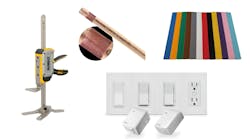More than other aspects of commercial lighting, the changing and complex technology of controls can result in lost time and money. When dealing with lighting controls, whether in new construction or a renovation, contracting firms face three characteristic (and potentially expensive) problems:
- Incomplete or ambiguous information about the control system leads to mistakes, time-consuming corrections, and a slow pace of work.
- Uncertainties about the scope and capabilities of the project team (architect, lighting designer, engineer, construction manager) can result in confusion that takes time to sort out and may leave gaps in responsibility, contributing to more time lost.
- Mixed or limited experience with connected lighting systems within your installation team slows the workflow and reduces efficiency compared to more familiar areas of expertise.
Issues with lighting controls play out across the various stages of the project whether you are preparing a bid, negotiating the purchase, planning the installation, or configuring the control settings.
For the last five years, the U.S. Department of Energy’s Next Generation Lighting Systems (NGLS) program has been researching issues dogging various types of lighting controls. In a 2019 EC&M article, I described the “living lab” environment where we work with project managers, installers, and other experts in the lighting world, looking at problems and considering solutions. In this piece, we’ll discuss the cost impact of issues from documentation to specialization and share some thoughts on better practices.
Documentation
Installers for today’s lighting controls typically face a significant problem: Information is inadequate about the system and how it is to be installed, configured, and used.
A document package for lighting controls can include familiar items, such as an electrical plan, single-line diagrams, a controls schedule, and specification language. But complete documentation should also include a written Controls Intent Narrative (CIN) and a Sequence of Operation (SoO).
The CIN explains the thinking behind the design, detailing the types of controls in each space (e.g., luminaire-integrated sensors), how the controls function (e.g., dimming in response to daylight), where the controls are located (e.g., keypad at the entry point and front of the room), how users operate them (e.g., multi-button keypad with labels for each scene), and what settings are needed (e.g., light output at 80% of maximum for task tuning).
The SoO provides specific settings for each component of the control system. These include, for example, time-out settings on occupancy sensors, specific levels for presets, a minimum dim level for daylight response, and so on. Installers find the SoO to be helpful at initial set-up and critical when configuring the system. Without this information, the configuration will likely need to be redone, or it won’t meet customer expectations.
An incomplete CIN often forces installers on a tight schedule to move forward and then backtrack to correct and repeat work. Without the CIN and SoO, your team may be flying blind at critical points in the installation and configuration process.
We often hear that critical information, such as the SoO or wiring diagrams, arrives on the job after installation. This gap may affect the ultimate performance of the system or require re-configuration, perhaps without compensation for those doing the work. Industry standards for the CIN and SoO are beginning to emerge from the specification community, but the practice is spotty and inconsistent.
Recognizing what documentation should be on hand (as discussed above) helps you press designers and the supply chain to complete the package.
Understanding the control system
Lighting controls vary significantly from one manufacturer or product family to another. There’s no escaping the need to understand the specific product you are going to install and configure. On top of this already complex scenario is the reality that any system can be here today and changed tomorrow – often by upgrades. Some upgrades are welcome; others unhinge previously working functions.
Instructions for installation or configuration rarely stand out for their clarity. They can be overly wordy and contain unfamiliar terms, often for familiar devices, which adds to the confusion. Illustrations from the product engineer’s perspective provide little assistance to an installer looking at a device up close and head-on.
When you select the control system, you can favor those systems you know well and prefer. But what if others are doing the choosing? In this case, your team must learn a new and potentially complex product from scratch.
Unfortunately, it’s often difficult to pore over instructions, especially lengthy materials that consume time we can’t spare. It’s worse when a new product looks like one we have handled before. We tend to approach these casually, assuming we know what it’s all about, then blunder into errors that might have been avoided with a closer reading of the instructions. One of my colleagues says an instruction sheet should clearly state right at the top of the page: “So, it isn’t working, huh?” That’s when many installers finally reach for the installation sheet — after they have already tried and failed to get the controls working. Wherever complex systems of any type run aground, a checklist of basic steps has proved the most effective way to instill a disciplined and successful work process. Interestingly, those who resist the checklist for themselves often find it useful in training others.
Finally (or, better yet, at the beginning), take advantage of the supply chain before problems arise. Most supply chain controls specialists eagerly introduce their products during bid preparation (they may have had a major role in project design) and at a pre-install conference. The good ones recognize that any lack of clarity or thoroughness on their part will result in problems that cost them time and money, too.
The team
Lighting controls (more than other aspects of lighting) offer the potential for misunderstanding and miscommunication among project team members and installers. An ambiguous or contradictory design generally means lost time that you may not be able to recoup.
I think it helps when you push the team — designers, engineers, consultants, and integrators — to resolve conflicts on a timely basis. While this may feel like their business and not yours, you have a lot at stake in the successful resolution. Otherwise, any collateral damage may fall on you. You don’t need to tell others how to do their jobs; just make sure that all the jobs necessary for a successful project are assigned.
Specialists
Complicated controls — especially systems marrying components from different manufacturers — require knowledgeable specialists. Bringing in a system integrator often can save time and material that justifies the fee involved. If an integrator is specified, all bidders can compete on a level field. Even when there’s no specification, engaging an integrator can pay off for you.
Increasingly, we see firms developing their own specialized capabilities. A team of specialists can perform system-specific tasks faster and more accurately than generalists. And the division of labor can improve the efficiency of installers now focused on more familiar light and power.
Controls expertise — ranging from energy code compliance to advanced system performance — plays an essential role when you are responsible for system design and selection, or even if your scope is just costing, installation, and setup. Specialized capabilities also open marketing opportunities in both service and construction.
The silver lining
Yes, connected lighting controls are complicated, and they often cost more than budgeted, especially in time and rework. The reward for this risk is two-fold: capability and marketing.
In terms of marketing, lighting controls can symbolize a successful, forward-thinking business model. Advanced, multi-purpose systems present building owners with critical questions about system type, capability, complexity, and cost. Companies that can answer these questions based on experience and savvy will hold more appeal than those stuck in the known world of older building technologies.
The Next Generation Lighting Systems program focuses on making lighting controls more successful, reducing wasted energy and environmental resources, and improving the building experience for occupants. While helping you make money is not my goal at NGLS, increasing the chance of your success with advanced lighting controls and the improved profitability that goes with it are happy outcomes in alignment with the objectives of NGLS.
If you have thoughts on lighting controls, or if this article has prompted some ideas, I would like to hear from you (contact me through the email listed below).
Ruth Taylor serves as a project manager on the Advanced Lighting Team at the Pacific Northwest National Laboratory where she contributes to multiple projects, including the management of Next Generation Lighting Systems (NGLS), a highly successful, nationally recognized program that encourages technical innovation and promotes excellence in the design of energy-efficient LED luminaires and connected lighting systems. She can be reached at [email protected].







